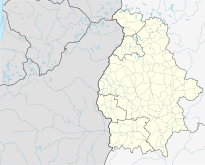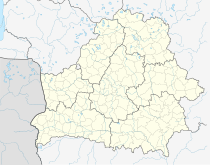Regions of Belarus
| Regions and the Special administrative district of Belarus Рэгіёны і Спецыяльны адміністратыўны раён Беларусі (in Belarusian) Регионы и Специальный административный район Беларуси (in Russian) | |
|---|---|
 | |
| Category | Unitary state |
| Location | Belarus |
| Created | 1960 |
| Number | 7 regions |
| Populations | (Regions only): 1,018,000 (Mogilev) – 1,987,000 (Minsk) |
| Areas | (provinces only): 25,118.1 km2 (9,698.14 sq mi) (Grodno) – 40,361.6 km2 (15,583.72 sq mi) (Gomel) |
| Government | province government |
| Subdivisions | Raion |
Belarus is divided into six oblasts (voblasts or provinces). These oblasts are the first-level subdivisions of Belarus. The city of Minsk[1] has a special status as the capital of Belarus. Minsk is also the capital of Minsk Region.[2]
The regions of Belarus are divided into raions (districts).
The layout and size of the regions were created in 1960 when Belarus (then the Byelorussian Soviet Socialist Republic) became a republic of the Soviet Union.[3]
History[change | change source]
At the start of the 20th century, the borders of the Belarusian lands in the Russian Empire were still being made. In 1900 it was made of the entire Minsk Governorate and Mogilev Governorate, most of Grodno Governorate, parts of Vitebsk Governorate, and parts of Vilna Governorate (Vilna Governorate is now in Lithuania).[4] World War I, the independence of Poland, and the 1920-1921 Polish–Soviet War changed the borders. In 1921, Belarus had what is now all of Minsk Region except for the western fringe, the western part of Gomel Region, a western slice of Mahilyow Region, and a small part of Vitebsk Region. In 1926, the eastern part of Gomel Region was added.[4]
In Soviet Belarus, new administrative units, called oblast or voblast were created in 1938. And again, during World War II, the borders changed. In 1939 they were reset with Belarus gaining territory to the west, Baranavichy, Belastok (Białystok), Brest, Pinsk, and Vileyka oblasts. In 1944 Belastok was removed and the new oblasts of Babruysk, Grodno, and Polotsk were created. At the same time, Vileyka Oblast was renamed Molodechno Oblast.[5]
At different times between 1938 and 1960, the following oblasts existed:
- Babruysk Oblast, created 1944, deleted 1954
- Baranavichy Oblast, created 1939, deleted 1954
- Belastok Oblast, created 1939, deleted 1944 (now Białystok in Poland)
- Brest Oblast, created 1939
- Gomel Oblast, created 1938
- Grodno Oblast, created 1944
- Maladzyechna Oblast renamed from Vileyka Oblast 1944, deleted 1960
- Mogilev Oblast, created 1938
- Minsk Oblast, created 1938
- Navahrudak Oblast, created 1939, renamed Baranavichy Oblast December 1939
- Pinsk Oblast, created 1939, deleted 1954
- Polatsk Oblast, created 1944, deleted 1954
- Polesia Oblast, created 1938, deleted 1954
- Vitebsk Oblast, created 1938
- Vileyka Oblast, created 1939, renamed to Maladzyechna Oblast 1944
Regions[change | change source]
| Flag | Region | Capital | Russian | Belarusian | Population
(2022)[6] |
Area
(km2) |
Density | Percentage
of Belarus | |
|---|---|---|---|---|---|---|---|---|---|
| 1 | Минск | Мінск | 1,987,000 | 305.50 | 6,606.48 | 21.44% | |||
| 2 | Brest | Brest | Брестская | Брэсцкая | 1,356,000 | 32,790.68 | 41.11 | 14.32% | |
| 3 | Gomel | Gomel | Гомельская | Гомельская | 1,380,000 | 40,361.66 | 34.40 | 14.75% | |
| 4 | Grodno | Grodno | Гродненская | Гродзенская | 1,037,000 | 25,118.07 | 40.88 | 10.91% | |
| 5 | Mogilev | Mogilev | Могилёвская | Магілёўская | 1,018,000 | 29,079.01 | 35.24 | 10.89% | |
| 6 | Minsk | Minsk | Минская | Мінская | 1,464,000 | 39,912.35 | 36.86 | 15.63% | |
| 7 | Vitebsk | Vitebsk | Витебская | Вiцебская | 1,128,000 | 40,049.99 | 28.36 | 12.06% | |
| Belarus | Minsk | Беларусь | 9,370,000 | 207,617.26 | 45.34 | 100.00% | |||
Historical division[change | change source]
References[change | change source]
- ↑ Belarus Regions
- ↑ Minsk summary Archived 2020-11-24 at the Wayback Machine, at the website of the Belarus embassy in Russia.
- ↑ "Regions of Belarus". Statoids.
- ↑ 4.0 4.1 "Regions of Belarus". Statoids.
- ↑ "Regions of Belarus". Statoids.
- ↑ Official 2022 census results
Other websites[change | change source]
- Interactive map of Belarus Archived 2021-08-18 at the Wayback Machine
- Regions (oblasts) of Belarus, The official President's website
- Geography of Belarus, The official website of Belarus Archived 2021-12-16 at the Wayback Machine
- Belarusian regions, towns and villages
- Current Status of United Nations Romanization Systems for Geographical Names of Belarus





